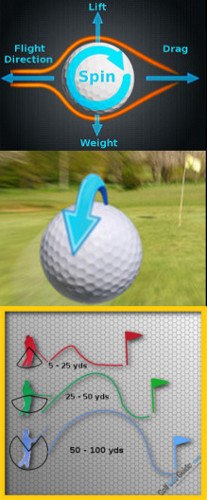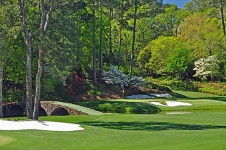When golfers think about course management, they typically focus on tee-to-green strategy – when to hit less than driver from the tee, where to lay up on a par 5 or how to handle a difficult pin placement. But course management is no less important when you're on or near the green.
Professional golfers' short games are extremely refined, so they mostly try to get their chips, bunker shots and long putts as close to the hole as possible. In fact, they're often thinking “make it” while standing over these shots.
Even so, the pros know that some hole locations are not to be trifled with. Sometimes, even the world's finest golfers are happy with results that don't earn a big cheer.
Why It's Important:

It's a widely known fact that putting accounts for about 40 percent of all shots in a given round, regardless of skill level. For amateurs, the next biggest share comes from within 50 yards of the green. In other words, the short game is the most important aspect of golf.
Good technique is essential to excelling here. But you can also shave strokes by making smart decisions on greenside shots as well as long putts. There are many lessons to learn by watching pro golfers.
Who You Should Watch:
In this case, it's not so much who as what. For example, take note of how the pros:
- Always get short putts to the hole: How often do you come up short from inside 5 feet? For the pros, the answer is next to never. From this distance the idea is to make it, every time.
- Try to hole out easy chips: In general, pros miss greens in spots that leave them a good chance to get up-and-down for par. (That's part of good tee-to-green course management.) They think about straightforward chips much like putts – an opportunity to sink it for birdie. Rather than baby the ball toward the cup and hope to get it close, they'll make a firm, aggressive stroke.
- “Bail out” on tough chips, pitches, bunker shots and putts: The pros are magicians around the green, but sometimes there's no rabbit to pull from the hat. Rather than attempting a miracle, they'll take their medicine, chip safely on and two-putt, thus averting a potential big number. You'll see a similar approach on long putts with a lot of break.
- Play the percentages: Many greenside situations offer different options. For instance, hitting a high shot that carries most of the way to the hole, or a low shot that bounces and rolls. Usually, pros will play the shot they're more likely to hit well, instead of the one that requires perfect execution to achieve a spectacular result.
- Leave the ball below the hole on fast greens: When watching the Masters, notice how the pros seldom leave a chip or long putt above the hole. Sure, they want to get close, but they don't want to face a downhill 4-foot putt for par. Sometimes, it pays to be cautious.
Apply It to Your Game:
Follow these tips to manage the greens like a pro:
- Be aggressive near the hole: Putt fearlessly when you're within 5 feet of the cup. In other words, don't worry about knocking the ball a few feet past and facing another knee-knocker. If short putting is that much of a struggle – and it is for everyone at one time or another – spend some time working it out on the practice green.
- Think about holing simple chip shots: Few moments in golf are as exciting – or as momentum-building -- as a chip-in. If you can play aggressively without risking a tough, downhill putt, take dead aim when you're closer than 30 feet.
- Play to the spot you want to putt from: Sometimes, thinking “get the ball as close as possible” isn't specific enough. If the greens are especially fast, you're better off with a 5-foot putt uphill than a 3-footer downhill. Aim for the spot that gives you a makeable putt.
- Hit the shot you're most comfortable with: If you've got two or more options for playing a chip or pitch, choose the shot you feel confident in hitting well. If you have a hard time playing a high lob, for example, hit a lower shot instead – even if it means sacrificing the chance to get very close. By eliminating the more difficult shot, you'll reduce the risk of flubbing it and making a big number.
Part I of this feature tackles the art of tee-to-green course management as practiced by professionals.

Watching the Pros Course Management – Part Two
There is much to be learned from watching professional golfers make their way around a course. Despite playing under intense pressure, with huge sums of money on the line, the average pro looks like he or she is out for a walk in the park. How do they make it look so easy? Well, for one thing, they have plenty of experience. It takes many years of practice to make it to the highest levels of this difficult game. In addition to that experience, professional golfers have a plan – and it is this plan that we will be talking about in this article.
When we talk about having a 'plan' on the golf course, what we are really talking about is course management. This is the skill of being able to pick the right club for the shot at hand, and the right target based on the design of the hole. Sadly, most amateur golfers overlook course management almost completely. Instead of thinking about how they can safely move the ball around the course, the average player is more concerned with maximizing distance to impress playing partners. If you are serious about shooting the lowest possible scores, you would be wise to pay close attention to your course management strategies.
In this article, we are going to talk about some of the course management tips you can pick up by watching professional golf. Whether you are watching on television or in person, you should be able to pick out at least a few key points that can be applied to your own game. Golf is a slow game, which makes it great as a teaching tool for amateur golfers. You will have plenty of time as you watch to think about course management strategies, and how you would deal with the same situation that the pro is facing.
The next time you have a chance to watch some golf on TV, try the following exercise. Before each shot, do your best to guess what kind of strategy the player is going to use. Which side of the hole will be used as the target? Are they going to maximize distance with the driver, or play it safe off the tee with a hybrid? There are countless decisions to be made during any round of golf, and trying to guess what the pros will do can help you become a better player in your own right.
Before we get started, it should be pointed out that you don't need to have professional golfer skills in order to benefit from course management. This is a common misconception among amateur golfers. Many players think course management only matters for those who can accurately control their shots time after time – but that just isn't the case. All players can benefit from thinking strategically, so get started as soon as possible. As your physical game continues to improve, your mental game can come right along with it.
All of the content below is based on a right-handed golfer. If you happen to play left-handed, please take a moment to reverse the directions as necessary.

Pros Hate Penalties
The first course management topic we are going to tackle is penalty shots. Specifically, how much professional golfers hate penalty shots. Now, on the surface, that might seem like an obvious statement. All golfers hate penalty shots, and professionals are no different in that regard than the rest of us. However, here's the difference – pro golfers will actually make course management decisions to avoid penalties, where the average golfer frequently will not do the same.
Let's imagine a par four with a large water hazard on the right side of the fairway. A tee shot hit with a driver is sure to find the water if it strays even a few yards to the right of the intended line. In this situation, many amateur golfers will still hit their driver and hope for the best. Some of those drives will turn out okay, of course, but some of them will wind up in the water. The advantage gained by hitting the ball farther down the fairway is usually going to be more than cancelled out by the addition of penalty strokes from the drives that end up in the pond. Unless you are an extremely accurate driver of the golf ball, it just isn't worth the risk to take on this kind of shot.
So, what would the average professional golfer do? Lay-up. More times than not, a pro golfer is going to simply use less club off the tee, in order to take the water completely out of the picture. By hitting something like a three wood or hybrid club, the water can be removed from the picture as a point of concern. Even if the shot misses the fairway to the right, the ball will not go far enough to reach the hazard (in this scenario). Through simple course management, risk will have been greatly reduced and a potential penalty shot will have been eliminated.
This concept can be applied in a variety of areas around the course. Anytime you are faced with a shot that could lead to a penalty, you will want to think twice about your plan. Is there anything you can do to eliminate the chance of a penalty, or at least reduce its likelihood? In some situations, you won't have a choice. For instance, if you are playing a par three which requires you to carry water from the tee to the green, you're just going to have to hit a good shot. You can't game plan away from all penalty shots, but do your best to reduce risk through smart decision making.
If you think about some of the best rounds you have played in your golfing life, it is likely that most (or all) of them included no penalty strokes. This is not a coincidence. Many golfers think they need to play aggressively in order to post low scores, but that is actually not the case. Most of the time, this is a game which will reward conservative, consistent play, rather than aggression. By keeping your ball in play and making smart choices, you can gradually lower your scores and have more fun on the course. Sure, the dramatic shots over water might make the highlight reel during a professional tournament, but it is the safer shots played during the rest of the round that lead to great results.
As the first building block of a great course management plan, make it a goal to avoid penalty strokes as frequently as possible. You are never going to be perfect in this regard, but it should always be in the back of your mind as a guiding principle. If you find yourself stuck on a particular shot, unsure of how to proceed, think about the possibility of penalty strokes and opt for the safer route. It takes patience to make these kinds of wise choices, but you will be rewarded in the end.

Pros Love Short Grass
Just as professional golfers hate to add penalty strokes to their scorecards, they also hate to play from the long grass. Keeping the ball on the short grass might seem like another obvious tip, but it is important just the same. You can probably already sense a theme here, between the importance of avoiding penalty strokes and the importance of keeping the ball on the short grass. Each of these keys is simple, which is true of almost all valuable course management advice. Keep your game simple, make wise decisions, and watch your scores come down.
In the modern age of golf, the rough that you find around the edges of the fairways and greens is not usually as punishing as it once was. This is due to a couple of factors. For one thing, golf courses want to encourage a reasonable pace of play, and deep grass is a sure way to slow down the average round. By keeping the rough trimmed rather short, courses can keep groups moving along. Also, the equipment used in today's game is better able to handle the rough, so you can hit better shots from off the fairway than you could in years gone by.
These changes, sadly, have caused many golfers to underestimate the importance of hitting the fairway. Now that the rough isn't so intimidating, you might think that it doesn't make much difference if you hit the fairway or the rough – as long as you have a clear shot to the green with your next shot. Don't make the mistake of thinking this way. You are going to be better off when playing from the short grass, and it is worth your effort to find this part of the course as often as possible.
Why is it still desirable to be on the short grass? Let's take a look at a few key points –
- Control the spin of the ball. You always want to have control over the spin of your shots. Spin plays a huge factor in golf, and you can use it to your advantage if you have the right set of skills. However, when playing from the rough, much of your ability to control spin is going to be taken away. This is why professional golfers find it particularly frustrating to stray from the short grass. Out of the rough, the ball is going to have less spin overall, and the path of your shots is going to be less predictable.
- Control your distance. This point relates to spin as well, but it deserves its own category. It should go without saying that it is tremendously important to manage the distance that you hit the ball each time you make a swing. Golfers tend to be obsessed with the direction of their shots, but distance is just as important. Without plenty of backspin on the ball, your shots are going to float up toward the target unpredictably, and they might not come down when you expect. If you ever see a professional golfer miss the target way long or way short, it is likely that the shot was played from the rough. By playing as many of your approach shots from the fairway as possible, you can improve on your ability to control distance.
- Keep options open. It is advantageous to have as many options as possible available for any given shot. For instance, you might decide that you want to hit a shot low due to the wind, or high because of a tree that you need to get over. Those are good decisions – provided the lie of the ball is going to allow you to hit those shots. With a clean lie on the short grass, you will be able to turn to nearly any shot you desire. Things get trickier out of the rough. For instance, it can be difficult to use a low-lofted club to hit a punch shot out of the rough, meaning you might not be able to keep your shot down out of the wind. Keeping your ball on the short grass means more options at your disposal, and more options should lead to lower scores.
So far in our discussion of course management strategies from the pros, we haven't hit on anything particularly surprising. You are going to want to avoid penalty strokes, and you are going to want to do your best to keep the ball on the short grass. These points might be pretty obvious, but that makes them no less important. Let's move on to some course management strategies which are focused on helping you get the most from your short game.







